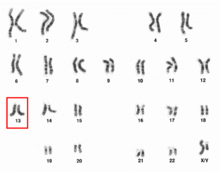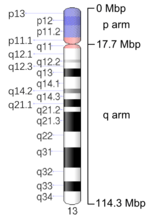Chromosome 13 (human)
| Chromosome 13 (human) | |
|---|---|
 Pair of human chromosome 13 (after G-banding). One is from mother, one is from father. | |
 Chromosome 13 pair in human male karyogram. | |
| Features | |
| Length (bp) | 114,364,328 bp |
| Number of genes | 993 |
| Type | Autosome |
| Centromere position | Acrocentric[1] |
| Identifiers | |
| RefSeq | NC_000013 |
| GenBank | CM000675 |

Chromosome 13 is one of the 23 pairs of chromosomes in humans. People normally have two copies of this chromosome. Chromosome 13 spans about 114 million base pairs (the building material of DNA) and represents between 3.5 and 4% of the total DNA in cells.
Identifying genes on each chromosome is an active area of genetic research. Because researchers use different approaches to predict the number of genes on each chromosome, the number of genes varies. Chromosome 13 likely contains between 300 and 700 genes.
Genes
The following are some of the genes located on chromosome 13:
- ATP7B: ATPase, Cu++ transporting, beta polypeptide (Wilson disease)
- BRCA2: breast cancer 2, early onset
- CARKD: Carbohydrate Kinase Domain Containing Protein (Unknown Function)
- EDNRB: endothelin receptor type B
- GJB2: gap junction protein, beta 2, 26kDa (connexin 26)
- GJB6: gap junction protein, beta 6 (connexin 30)
- HTR2A: 5-HT2A receptor
- PCCA: propionyl Coenzyme A carboxylase, alpha polypeptide
- RB1: retinoblastoma 1 (including osteosarcoma)
- FLT1: Fms related tyrosine kinase 1 (Vascular endothelial growth factor receptor 1)
- SLITRK1: mutation in this gene causes some (although very few) cases of Tourette syndrome and trichotillomania
- SOX21: Transcription factor SOX-21 is a protein that in humans is encoded by the SOX21; its disruption can lead to types of alopecia in mice.
- TPT1: Translationally controlled tumor protein (TCTP)
Diseases and disorders
The following diseases and disorders are some of those related to genes on chromosome 13:
- 13q deletion syndrome
- Bladder cancer
- Breast cancer
- Heterochromia
- Hirschsprung's disease
- Maturity onset diabetes of the young type 4
- Nonsyndromic deafness
- Nonsyndromic deafness, autosomal dominant
- Nonsyndromic deafness, autosomal recessive
- Propionic acidemia
- Retinoblastoma
- Schizophrenia
- Waardenburg syndrome
- Wilson's disease
- Patau syndrome
- Chronic Lymphocytic Leukemia (Acquired defect)
- Young–Madders syndrome
Chromosomal conditions
The following conditions are caused by changes in the structure or number of copies of chromosome 13:
- Retinoblastoma: A small percentage of retinoblastoma cases are caused by deletions in the region of chromosome 13 (13q14) containing the RB1 gene. Children with these chromosomal deletions may also have mental retardation, slow growth, and characteristic facial features (such as prominent eyebrows, a broad nasal bridge, a short nose, and ear abnormalities). Researchers have not determined which other genes are located in the deleted region, but a loss of several genes is likely responsible for these developmental problems.
- Trisomy 13: Trisomy 13 occurs when each cell in the body has three copies of chromosome 13 instead of the usual two copies. Trisomy 13 can also result from an extra copy of chromosome 13 in only some of the body's cells (mosaic trisomy 13). In a small percentage of cases, trisomy 13 is caused by a rearrangement of chromosomal material between chromosome 13 and another chromosome. As a result, a person has the two usual copies of chromosome 13, plus extra material from chromosome 13 attached to another chromosome. These cases are called translocation trisomy 13. Extra material from chromosome 13 disrupts the course of normal development, causing the characteristic signs and symptoms of trisomy 13. Researchers are not yet certain how this extra genetic material leads to the features of the disorder, which include severely abnormal cerebral functions, a small cranium, retardation, non functional eyes and heart defects.
- Other chromosomal conditions: Partial monosomy 13q is a rare chromosomal disorder that results when a piece of the long arm (q) of chromosome 13 is missing (monosomic). Infants born with partial monosomy 13q may exhibit low birth weight, malformations of the head and face (craniofacial region), skeletal abnormalities (especially of the hands and feet), and other physical abnormalities. Mental retardation is characteristic of this condition. The mortality rate during infancy is high among individuals born with this disorder. Almost all cases of partial monosomy 13q occur randomly for no apparent reason (sporadic).
References
- Baud O, Cormier-Daire V, Lyonnet S, Desjardins L, Turleau C, Doz F (1999). "Dysmorphic phenotype and neurological impairment in 22 retinoblastoma patients with constitutional cytogenetic 13q deletion". Clin Genet. 55 (6): 478–82. doi:10.1034/j.1399-0004.1999.550614.x. PMID 10450867.
- Dunham A, Matthews LH, Burton J, Ashurst JL, Howe KL, Ashcroft KJ, Beare DM, Burford DC, Hunt SE, Griffiths-Jones S, Jones MC, Keenan SJ, Oliver K, Scott CE, Ainscough R, Almeida JP, Ambrose KD, Andrews DT, Ashwell RI, Babbage AK, Bagguley CL, Bailey J, Bannerjee R, Barlow KF, Bates K, Beasley H, Bird CP, Bray-Allen S, Brown AJ, Brown JY, Burrill W, Carder C, Carter NP, Chapman JC, Clamp ME, Clark SY, Clarke G, Clee CM, Clegg SC, Cobley V, Collins JE, Corby N, Coville GJ, Deloukas P, Dhami P, Dunham I, Dunn M, Earthrowl ME, Ellington AG, Faulkner L, Frankish AG, Frankland J, French L, Garner P, Garnett J, Gilbert JG, Gilson CJ, Ghori J, Grafham DV, Gribble SM, Griffiths C, Hall RE, Hammond S, Harley JL, Hart EA, Heath PD, Howden PJ, Huckle EJ, Hunt PJ, Hunt AR, Johnson C, Johnson D, Kay M, Kimberley AM, King A, Laird GK, Langford CJ, Lawlor S, Leongamornlert DA, Lloyd DM, Lloyd C, Loveland JE, Lovell J, Martin S, Mashreghi-Mohammadi M, McLaren SJ, McMurray A, Milne S, Moore MJ, Nickerson T, Palmer SA, Pearce AV, Peck AI, Pelan S, Phillimore B, Porter KM, Rice CM, Searle S, Sehra HK, Shownkeen R, Skuce CD, Smith M, Steward CA, Sycamore N, Tester J, Thomas DW, Tracey A, Tromans A, Tubby B, Wall M, Wallis JM, West AP, Whitehead SL, Willey DL, Wilming L, Wray PW, Wright MW, Young L, Coulson A, Durbin R, Hubbard T, Sulston JE, Beck S, Bentley DR, Rogers J, Ross MT (2004). "The DNA sequence and analysis of human chromosome 13". Nature. 428 (6982): 522–8. doi:10.1038/nature02379. PMC 2665288
 . PMID 15057823.
. PMID 15057823. - Gilbert F (2000). "Chromosome 13". Genet Test. 4 (1): 85–94. doi:10.1089/109065700316543. PMID 10794368.
- Kivela T, Tuppurainen K, Riikonen P, Vapalahti M (2003). "Retinoblastoma associated with chromosomal 13q14 deletion mosaicism". Ophthalmology. 110 (10): 1983–8. doi:10.1016/S0161-6420(03)00484-6. PMID 14522775.
| Wikimedia Commons has media related to Human chromosome 13. |
- ↑ "Table 2.3: Human chromosome groups". Human Molecular Genetics (2nd ed.). Garland Science. 1999.